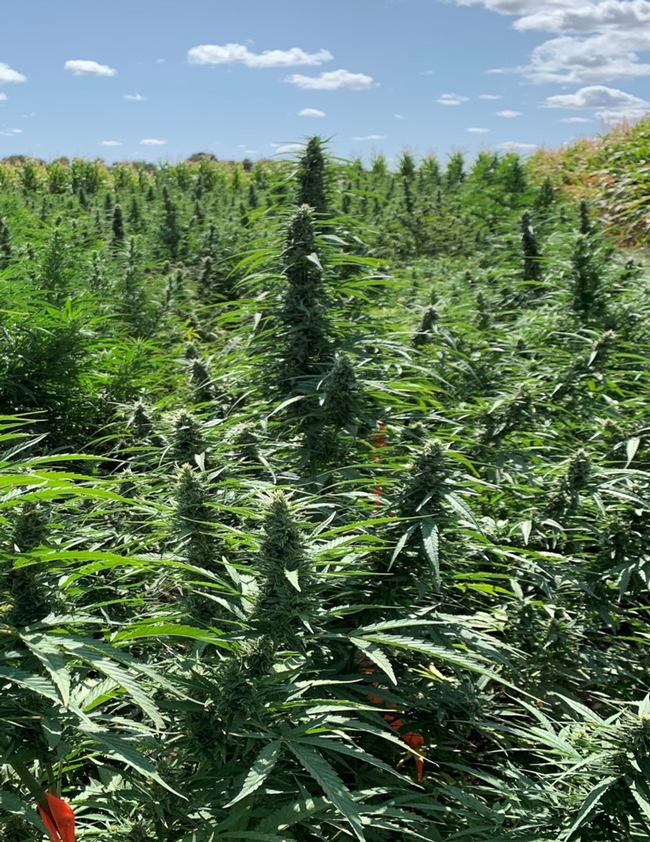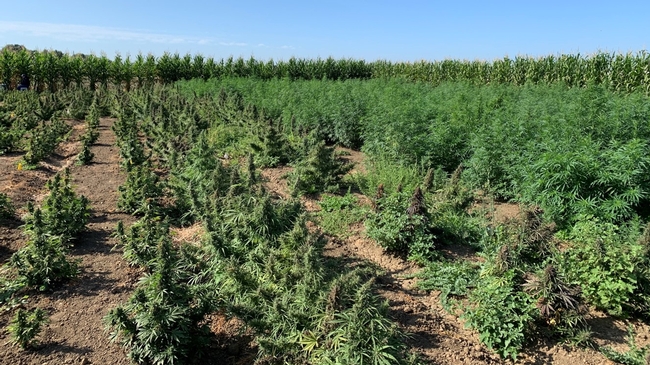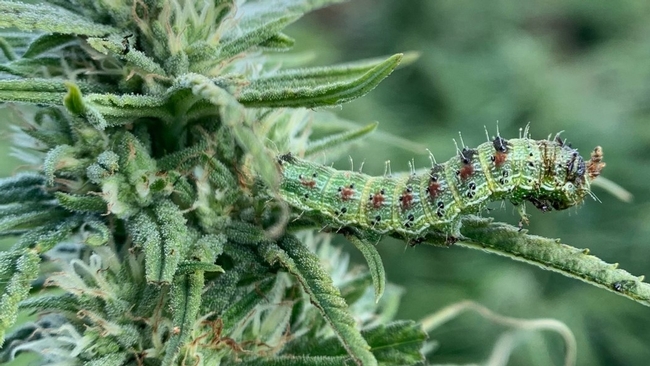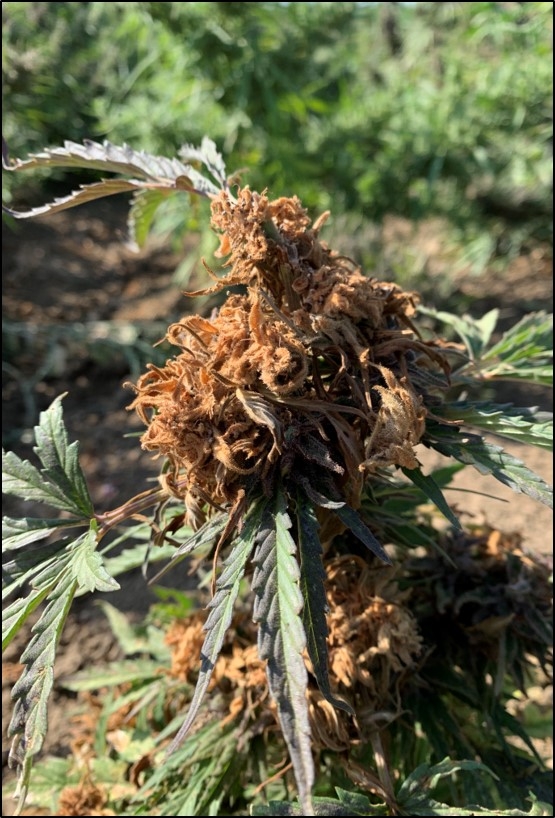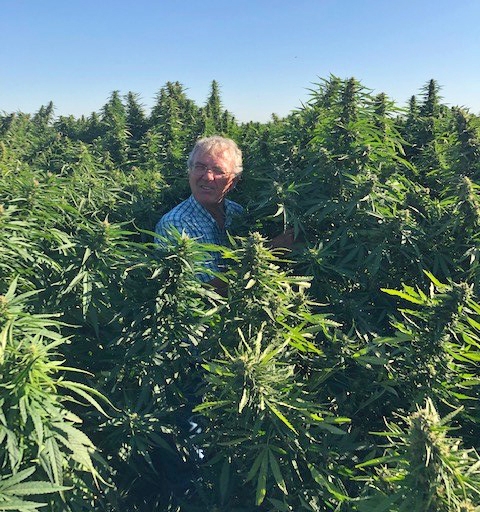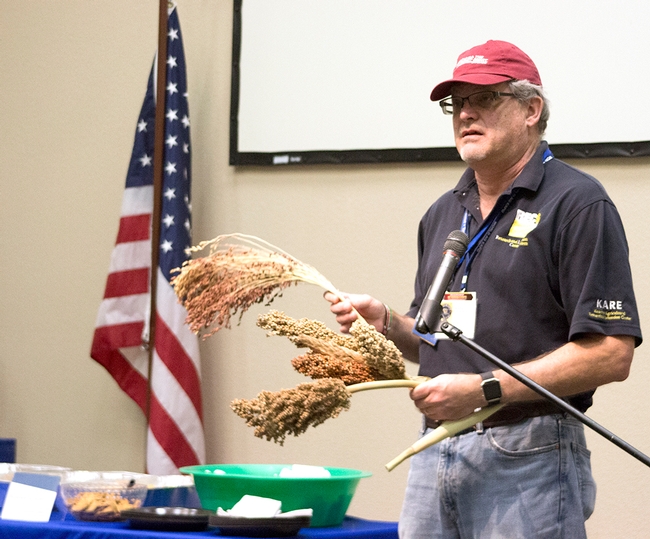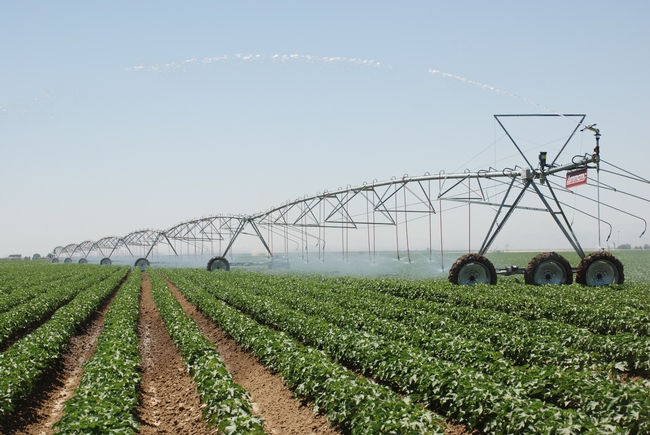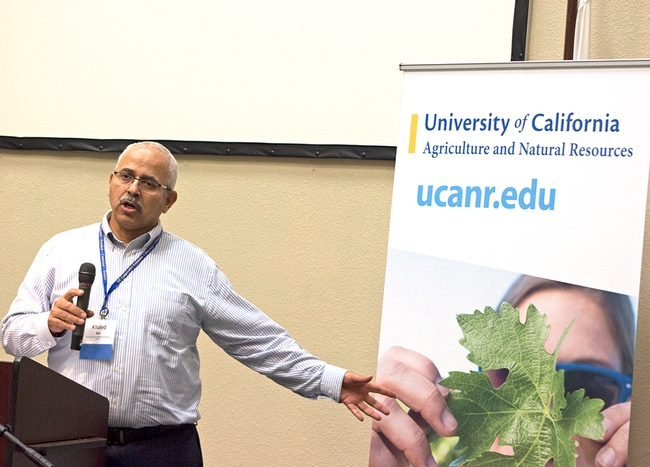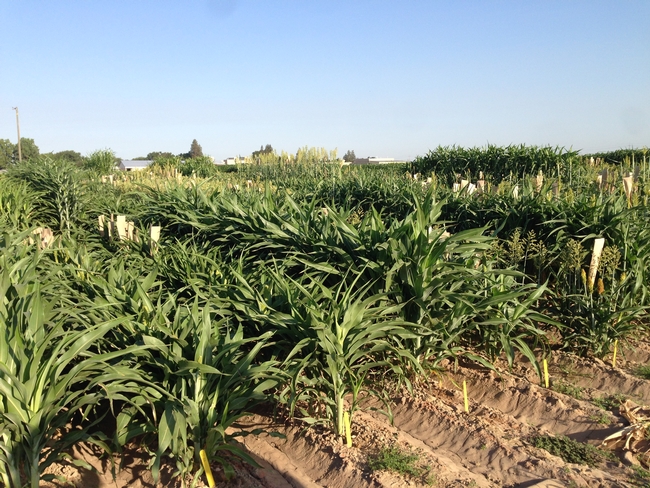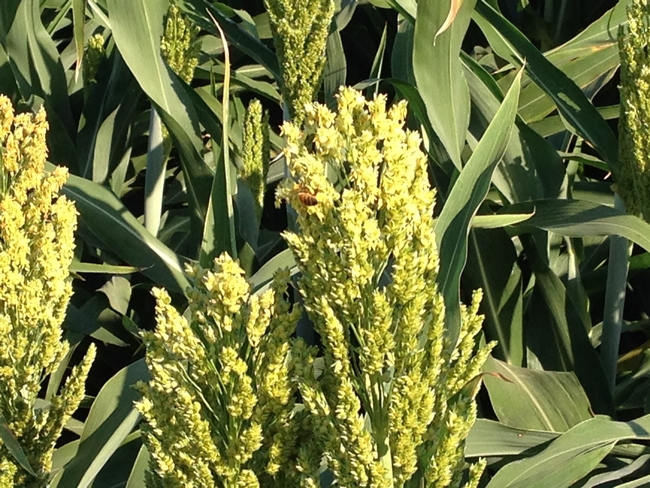Posts Tagged: Bob Hutmacher
Early UC hemp research already yielding results
For the first time ever, UC Agriculture and Natural Resources (UC ANR) researchers harvested an industrial hemp crop at one of its nine research and extension centers this fall.
“It's an interesting crop,” said UC Cooperative Extension specialist Bob Hutmacher. “There is a tremendous amount of research that can be done to understand its growth and best cultural practices, optimal planting dates either by seed or transplants, irrigation and fertilization management, and, particularly, to address pest and disease management.”
The research project is part of a two-location study, one at the UC West Side Research and Extension Center (WSREC) in Five Points, in western Fresno County, and an identical companion study at the UC Davis farm headed by UC Cooperative Extension specialist Dan Putnam and UC Davis professor and plant breeder Charles Brummer. These initial studies included a planting density by variety trial and a breeding observation block representing a wide range of genetics. The research was launched mid-summer this year after the 2018 Farm Bill declared that hemp should no longer be considered a controlled substance, but rather an agricultural commodity.
Industrial hemp can be produced for grain and fiber, however, many growers currently consider the most profitable component of the crop to be cannabidiol, or CBD, and related compounds. CBD is valued for its purported health benefits. It is said to reduce inflammation, pain, nausea, depression and anxiety, among other conditions.
Hutmacher said he and colleagues around the state are interested in learning about industrial hemp production opportunities, and feel there is a place for UC ANR research to support the fledgling industry. Already, there are some observations coming out of these small trials.
“Some people believe that hemp is a pest- and disease-free plant. That's not what we found,” Hutmacher said. “In the absence of suitable measures for control, corn ear worms seemed to thrive in hemp, and did an astounding amount of damage to cultivars in our small plots.”
The scientists were forced to use a pesticide to control the pest and reduce damage to developing buds. The hemp produced in the trial will be destroyed after harvest data has been collected. The experience with corn ear worm and other pest issues demonstrate that pest control will require significant study, particularly if a goal is to produce the crop organically.
“Markets for some industrial hemp products may require low pesticide residues. If hemp is produced organically, some preliminary observations this year suggest farmers will have to put a big effort into pest and disease control,” he said.
Plant breeding can be another area of UC research. Hemp's natural genetic variations produce plants that vary widely in growth habit, size, response to day length, and time to maturity. There are hemp cultivars that mature when the plant is 18 inches tall and others that shoot up 12 feet high at maturity. Hemp grown for CBD production from seed or as transplants can vary greatly in size and other characteristics, such as amount of branching and the number of flower structures per plant. Multiple plant and production system factors also will influence options for mechanical versus hand harvesting.
Another breeding concern for growers is producing a crop with economic levels of CBD or other compounds of commercial interest, while staying within regulatory limits for THC (tetrahydrocannabinol), the psychoactive compound found in marijuana, a related plant. According to the California Department of Food and Agriculture, an industrial hemp crop grown in the state may have no more than 0.3% THC when plant samples are analyzed.
“This will be a challenge for growers. You don't want to risk too high a THC level,” Hutmacher said. “Farmers must test to make sure THC is at a level to meet regulations. If it's too high, CDFA regulations would require the crop be destroyed.”
Working with UC breeders, integrated pest management scientists, agronomists, irrigation specialists and agricultural engineers, there should be good opportunities to finesse hemp production at UC ANR's network of research and extension center system across California.
Research center locations stretch from Holtville, in the low desert at the California-Mexico border, to Tulelake, just south of the Oregon border. Other centers ideal to answer hemp research questions include the UC Davis campus, the Hopland REC in Mendocino County, the Hansen REC in Ventura County, and the South Coast REC in Orange County.
UC ANR plans to expand its hemp research in 2020. For more information, contact Bob Hutmacher at (559) 260-8957 or rbhutmacher@ucdavis.edu.
The drought may be over, but water concerns haven't been doused
Record winter rainfall during the 2016-17 winter has enabled farms to emerge from survival mode in the short term, but scientists are still working hard to be ready for the next drought, reported Tim Hearden in Capital Press.
Hearden spent a day at the UC Kearney Agricultural Research and Extension Center in Parlier to learn how researchers at the facility and the UC West Side Research and Extension Center near Five Points are combining technology with management practices to put every drop of irrigation water to work.
“This is one of the few places in the world where you can do drought research on a field level,” said Jeff Dahlberg, director of the 330-acre Kearney facility. “What I'm planning is a world-class drought nursery.”
At the West Side REC, researchers are working with farmers to perfect micro-irrigation efficiency and test drought stress on the area's most prevalent crops.
“We'll grow a tremendous number of cultivars of a crop” and identify “what seem to be the most promising cultivars when you grow them under drought conditions,” said Bob Hutmacher, a cotton specialist and the center's director.
Hearden spoke to Jeff Mitchell, UCCE cropping systems specialist and director of the Conservation Agriculture Systems Innovation center (CASI). CASI is encouraging farmers to adopt farming practices that save water, reduce dust and help improve the condition of soil, such as subsurface drip irrigation, overhead irrigation, minimum tillage, cover crops and crop residues.
“This is not done right now in California,” Mitchell said. “In the future, there may be a strong likelihood of certain agricultural sectors adopting these practices.”
Other subsurface irrigation trials are showing dramatic increases in yields. Khaled Bali, an irrigation water management specialist at Kearney, said underground drip systems in alfalfa fields have achieved 20 to 30 percent more yields while in some cases using 20 percent less water.
Kevin Day, a UCCE pomology advisor in Tulare County, is trying subsurface drip in a peach and nectarine orchard after working with the USDA to use it for pomegranates. He's seen as much as a 90 percent reduction in weeds because there's no surface water to feed them.
“Fewer weeds, fewer pesticides,” he said. “We use high-frequency irrigation. We irrigate as the crop needs it. When you do that, you keep the roots deeper, which makes for better aeration.”
Sorghum growing in the San Joaquin Valley is the subject of $12.3M study of crop drought tolerance
UC Agriculture and Natural Resources researchers are working in the San Joaquin Valley with UC Berkeley and Department of Energy (DOE) scientists to examine the role of epigenetics in plant survival under drought conditions, an increasing concern for agriculture as the effects of climate change are felt in California and globally.
The five-year study is funded with a $12.3 million grant from the DOE.
Epigenetics is the study of trait variations caused by environmental factors that switch genes on and off. At the UC Kearney Agricultural Research and Extension Center in Parlier and the UC West Side Research and Extension Center in Five Points, sorghum nurseries will be grown under drought and well-watered conditions to compare the environmental impacts on the plants' gene expression.
“We hope to tease out the genetics of drought tolerance in sorghum,” said Jeff Dahlberg, a sorghum expert who will manage the trials at Kearney. “Using sorghum as a model, we expect this research to help us understand drought tolerance in other crops as well.”
Dahlberg is the director of the UC Kearney Research and Extension Center. The director of the UC West Side Research and Extension, Bob Hutmacher, will manage the sorghum nursery at that facility. Funds from the DOE grant will allow Dahlberg and Hutmacher to hire two research associates and purchase new research equipment, including a new planter, a plot combine, a forage chopper and specialized tools for measuring data.
Peggy Lemaux, UC ANR Cooperative Extension plant biology specialist based at UC Berkeley, is the overall leader of the project, titled Epigenetic Control of Drought Response in Sorghum or EPICON. Other collaborators are Devin Coleman-Derr, Elizabeth Purdom and John Taylor from UC Berkeley; Chia-Lin Wei from the DOE Joint Genome Institute; and Christer Jansson from the DOE Pacific Northwest National Laboratory.
Over the next three years, a variety of observable plant traits will be followed, such as plant height and grain yield. In addition, leaf and root samples will be taken to investigate responses to drought at the molecular level, including how gene expression changes and which proteins and metabolites are altered.
Researchers will also be tracking changes in the sorghum-associated microbial communities in the soil to determine whether they correlate with changes that directly contribute to the crop's drought tolerance. It is now well known that associations of specific bacteria and fungi with plants and animals have positive effects on host fitness. For example, microbes in both plants and humans are known to help fight disease and, in the soil, can help deliver nutrients and other resources to plants.
EPICON efforts will generate a variety of large datasets, which will be shared via an open, online platform that will include methods and results.
"Availability of this data in an open forum will enable comparative genomic studies by other scientists," said Coleman-Derr, a UC Berkeley adjunct assistant professor in plant and microbial biology. "Being able to analyze the large datasets in an integrated fashion will enable a more thorough understanding of the complex and interconnected processes responsible for sorghum's ability to respond positively to drought."
The researchers expect that the project will allow better predictions of how sorghum and other cereal crops are affected by future climate scenarios, and will lead to approaches to improve growth and production of sorghum and other crops under water-limiting conditions in commercial fields and on marginal lands.
The Energy Department's Genomic Science Program is funding this project through its Office of Biological and Environmental Research.
CONTACTS:
Jeff Dahlberg, jadahlbergt@ucanr.edu, (559) 646-6060
Bob Hutmacher, rbhutmacher@ucdavis.edu, (559) 884-2411, Ext. 206
Peggy Lemaux, lemauxpg@berkeley.edu, (510) 642-1589
Agriculture research not immune to drought
Fitchette opened his story with the plight of ag research at the UC West Side Research and Extension Center near Five Points. Many of the farmers in the area will receive no surface water allocation this year; neither will the research center.
The facility can pull water from a deep well, but it is not enough nor is the water quality adequate for all the farming operations, said Bob Hutmacher, UC Cooperative Extension specialist and center director. He said scientists at the station must cut back their water use this year by 25 percent.
“I can speak for myself: I have about a half dozen cotton projects and a sorghum project, along with a sesame project and a couple of other things I'm working on,” he said. “I'm downsizing most of them to the greatest degree I can and I'm going to cancel one of them.”
One trial that will not go forward at West Side is an almond variety trial. However, UC Cooperative Extension advisors in other areas are working with the Almond Board to keep the research underway. UCCE advisors Joe Connell will oversee the Chico State almond variety trial, Roger Duncan the Salida trial, and Gurreet Brar the Madera County trial.
The Western Farm Press Story included drought-related ag research news from myriad UCCE academics:
- Duncan said his work with fruit and nut crops has not been negatively impacted by the drought.
- David Doll, UCCE advisor in Merced County, said the increased reliance on groundwater has ruined several orchard nitrogen trials because the groundwater in northern Merced has high rates of nitrate nitrogen, which acts as a nitrogen fertilizer.
- Dan Munk, UCCE advisor in Fresno County, said he will continue putting off alfalfa trials at the WSREC “indefinitely until a more secure water supply is available.”
- Scott Stoddard, UCCE advisor in Merced County, reports positive and negative impacts from the drought. He won't do tomato research at West Side REC, but will continue work in sweet potatoes to determine how little water they need to produce a reasonable crop.
- Chris Greer, UCCE advisor in Sutter, Yuba, Colusa and Glenn counties, said some rangeland trials were impacted by the lack of rain.
- Bruce Lampinen, UCCE specialist in the Department of Plant Sciences at UC Davis, has seen his orchard trials in Arbuckle severely impacted by the drought.

